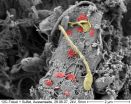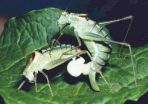(Press-News.org) Nanocrystals as protective coatings for advanced gas turbine and jet engines are receiving a lot of attention for their many advantageous mechanical properties, including their resistance to stress. However, contrary to computer simulations, the tiny size of nanocrystals apparently does not safeguard them from defects.
In a study by researchers with the U.S. Department of Energy (DOE)'s Lawrence Berkeley National Laboratory (Berkeley Lab)and collaborators from multiple institutions, nanocrystals of nickel subjected to high pressure continued to suffer dislocation-mediated plastic deformation even when the crystals were only three nanometers in size. These experimental findings, which were carried out at Berkeley Lab's Advanced Light Source (ALS), a premier source of X-rays and ultraviolet light for scientific research, show that dislocations can form in the finest of nanocrystals when stress is applied.
"We cannot ignore or underestimate the role of dislocations – defects or irregularities – in fine nanocrystals as external stress can change the entire picture," says Bin Chen, a materials scientist with the ALS Experimental Systems Group who led this research. "Our results demonstrate that dislocation-mediated deformation persists to smaller crystal sizes than anticipated, primarily because computer models have not given enough consideration to the effects of external stress and grain boundaries."
Chen is the lead and corresponding author of a paper in Science describing this work. The paper is titled "Texture of Nanocrystalline Nickel: Probing the Lower Size Limit of Dislocation Activity." Co-authoring this paper were Katie Lutker, Selva Vennila Raju, Jinyuan Yan, Waruntorn Kanitpanyacharoen, Jialin Lei, Shizhong Yang, Hans-Rudolf Wenk,
Ho-kwang Mao and Quentin Williams.
Plastic deformation is a permanent change in the shape or size of a material as the result of an applied stress. The likelihood of plastic deformation increases with the presence of dislocations – defects or irregularities – within the material's structure. Most materials are made up of small crystals, called "grains," and what happens at the boundaries between these grains is critical to material properties. Based on computer simulations and electron microscopy analysis, the belief has been that dislocation-mediated plastic deformation becomes inactive below a grain size of at least 10 nanometers, and possibly as large as 30 nanometers.
"The idea was that below a critical length scale, dislocation-mediated deformation activity would give way to grain-boundary sliding, diffusion, and grain rotation," Chen says. "However, there were many unresolved questions with regards to whether plasticity in ultrafine nanocrystalline grains could still be generated by dislocations and how pressure might affect the deformational regimes."
To investigate grain size and pressure effects on the plastic deformation of nanometals, Chen and his colleagues used ALS Beamline 12.2.2, a superconducting bend magnet beamline that supports radial diamond-anvil-cell X-ray diffraction experiments. Chen and his co-authors recorded in situ observations under a range of high pressures of texturing (when the crystalline grains have preferred orientations) in stressed polycrystalline nickel samples featuring grain sizes of 500-, 20- and 3-nanometers.
"Substantial texturing was observed at pressures above 3.0 gigapascals for nickel with 500-nanometer grain size and at greater than 11.0 gigapascals for nickel with 20-nanometer grain size," Chen says. "Surprisingly, texturing was also seen in nickel with 3-nanometer grain size when compressed above 18.5 gigapascals. This tells us that under high external pressures, dislocation activity can be extended down to a few-nanometers-length scale."
Chen and his co-authors started with nanocrystalline nickel because its face-center cubic structure remains stable under a wide pressure range. They are now applying their techniques to the study of other nanocrystalline materials, both metals and non-metals.
INFORMATION:
This research was funded by the National Science Foundation, NASA, and the DOE Office of Science. The ALS is a DOE Office of Science national user facility.
Lawrence Berkeley National Laboratory addresses the world's most urgent scientific challenges by advancing sustainable energy, protecting human health, creating new materials, and revealing the origin and fate of the universe. Founded in 1931, Berkeley Lab's scientific expertise has been recognized with 13 Nobel prizes. The University of California manages Berkeley Lab for the U.S. Department of Energy's Office of Science. For more, visit www.lbl.gov.
DOE's Office of Science is the single largest supporter of basic research in the physical sciences in the United States, and is working to address some of the most pressing challenges of our time. For more information, please visit the Office of Science website at science.energy.gov/.
Nanocrystals not small enough to avoid defects
Berkeley Lab scientists at advanced light source show dislocations can be induced by pressure in ultrafine nanocrystals
2012-12-14
ELSE PRESS RELEASES FROM THIS DATE:
Hard-to-treat Myc-driven cancers may be susceptible to drug already used in clinic
2012-12-14
PHILADELPHIA — Drugs that are used in the clinic to treat some forms of breast and kidney cancer and that work by inhibiting the signaling molecule mTORC1 might have utility in treating some of the more than 15 percent of human cancers driven by alterations in the Myc gene, according to data from a preclinical study published in Cancer Discovery, a journal of the American Association for Cancer Research.
"More than 1 million people diagnosed with cancer each year have a tumor driven by alterations in the Myc gene," said Grant A. McArthur, M.D., Ph.D., professor of translational ...
Use 'em, don't lose 'em! Eating egg yolks adds nutritious benefits
2012-12-14
Park Ridge, Ill. (December 14, 2012) – It is estimated that 34% of Americans are affected by an increasingly prevalent condition known as metabolic syndrome which is a combination of at least three of the following risk factors: large waistline, high triglycerides, low HDL cholesterol, high blood pressure and elevated blood sugar.(i) These individuals have a variety of risk factors that increase the likelihood of developing diabetes and cardiovascular disease. Decades of mixed messaging regarding dietary cholesterol have led to avoidance of certain foods, such as eggs, ...
Biostatistics serving biomedicine: International meeting of biostaticians in Barcelona
2012-12-14
Statistics have entered the life sciences and they are here to stay. This science emerged in the XVIII century by the hand of the mathematicians Thomas Bayes and Pierre Simon Laplace and was used by Gregor Mendel to demonstrate his theory on genetic inheritance. Since the 90s with the appearance of large genomic studies, statistics has become a fundamental tool for the analysis and interpretation of biomedical data. "Today it is difficult to find a scientific article in the field of biomedicine that does not include statistical methodology" explains David Rossell, who performed ...
1 in 10 6- to 8-year-olds has sleep-disordered breathing
2012-12-14
Approximately ten per cent of 6 year olds have sleep-disordered breathing, according to a recent Finnish study. The risk is increased among children with enlarged tonsils, crossbite and convex facial profile. Unlike in adults, excess body fat is not associated with sleep-disordered breathing in this age group. The study was part of the Physical Activity and Nutrition in Children (PANIC) Study led by the Institute of Biomedicine at the University of Eastern Finland. The results were published in European Journal of Pediatrics.
The symptoms of sleep-disordered breathing ...
Schizophrenia linked to social inequality
2012-12-14
Higher rates of schizophrenia in urban areas can be attributed to increased deprivation, increased population density and an increase in inequality within a neighbourhood, new research reveals. The research, led by the University of Cambridge in collaboration with Queen Mary University of London, was published today in the journal Schizophrenia Bulletin.
Dr James Kirkbride, lead author of the study from the University of Cambridge, said: "Although we already know that schizophrenia tends to be elevated in more urban communities, it was unclear why. Our research suggests ...
NHS consultant contract fails to increase productivity
2012-12-14
An employment contract for NHS consultants introduced in 2003 and including a 27 per cent pay rise over three years failed to increase productivity. The findings emerge from a 10-year study of hospital consultant activity, published today by the Journal of the Royal Society of Medicine, which looked at the levels of consultant clinical activity rates between 1999 and 2009. The researchers found that, despite an expectation by the Department of Health that the contract would result in year-on-year productivity gains of 1.5%, consultant activity levels showed a downward trend. ...
Changes in the gut bacteria protect against stroke
2012-12-14
Researchers at the University of Gothenburg, Sweden, and the Chalmers University of Technology, Sweden, demonstrate that an altered gut microbiota in humans is associated with symptomatic atherosclerosis and stroke. These findings are presented in a study published in Nature Communications on December 4.
The human body contains ten times more bacterial cells than human cells, most of which are found in the gut. These bacteria contain an enormous number of genes in addition to our host genome, and are collectively known as the gut metagenome.
How does the metagenome ...
Pitt Cancer Institute finds new targets for drugs to defeat aggressive brain tumor
2012-12-14
PITTSBURGH, Dec. 13, 2012 – University of Pittsburgh Cancer Institute (UPCI) researchers have identified over 125 genetic components in a chemotherapy-resistant, brain tumor-derived cell line, which could offer new hope for drug treatment to destroy the cancer cells.
The results will be reported in the cover story of December's issue of the journal Molecular Cancer Research, to be published Dec. 18 and currently available online.
The potential drug targets were identified after testing more than 5,000 genes derived from glioblastoma multiforme, an aggressive brain ...
Fertile soil doesn't fall from the sky
2012-12-14
This press release is available in German.
Leipzig. Remains of dead bacteria have far greater meaning for soils than previously assumed. Around 40 per cent of the microbial biomass is converted to organic soil components, write researchers from the Helmholtz Centre for Environmental Research (UFZ), the Technische Universität Dresden (Technical University of Dresden) , the University of Stockholm, the Max-Planck-Institut für Entwicklungsbiologie (Max Planck Institute for Developmental Biology) and the Leibniz-Universität Hannover (Leibniz University Hannover) in the ...
Male bushcrickets are in charge when it comes to sex
2012-12-14
This press release is available in German.
All a question of timing: When bushcrickets mate, the male attaches a sticky package, the so-called spermatophore, to the female's abdomen. Alongside the sperm themselves, this 'bridal present' consists of a protein-rich mass that the female eats after mating. It then takes several hours for the sperm to find their way into the female's reproductive tract. But, who decides when that will happen? A study by the Bielefeld biologists Professor Dr. Klaus Reinhold and Dr. Steven Ramm suggests that it is the male who determines the ...
LAST 30 PRESS RELEASES:
This new understanding of T cell receptors may improve cancer immunotherapies
A new fossil face sheds light on early migrations of ancient human ancestor
A new immunotherapy approach could work for many types of cancer
A new way to diagnose deadly lung infections and save lives
40 percent of MRI signals do not correspond to actual brain activity
How brain-inspired algorithms could drive down AI energy costs
Gum disease may be linked to plaque buildup in arteries, higher risk of major CVD events
Contrails are a major driver of aviation’s climate impact
Structure of dopamine-releasing neurons relates to the type of circuits they form for smell-processing
Reducing social isolation protects the brain in later life
Keeping the heart healthy increases longevity even after cancer
Young adults commonly mix cannabis with nicotine and tobacco
Comprehensive review illuminates tau protein's dual nature in brain health, disease, and emerging psychiatric connections
Book prepares K-12 leaders for the next public health crisis
Storms in the Southern Ocean mitigates global warming
Seals on the move: Research reveals key data for offshore development and international ecology
Sports injuries sustained during your period might be more severe
World's first successful 2 Tbit/s free-space optical communication using small optical terminals mountable on satellites and HAPS
Can intimate relationships affect your heart? New study says ‘yes’
Scalable and healable gradient textiles for multi‑scenario radiative cooling via bicomponent blow spinning
Research shows informed traders never let a good climate crisis go to waste
Intelligent XGBoost framework enhances asphalt pavement skid resistance assessment
Dual-function biomaterials for postoperative osteosarcoma: Tumor suppression and bone regeneration
New framework reveals where transport emissions concentrate in Singapore
NTP-enhanced lattice oxygen activation in Ce-Co catalysts for low-temperature soot combustion
Synergistic interface engineering in Cu-Zn-Ce catalysts for efficient CO2 hydrogenation to methanol
COVID-19 leaves a lasting mark on the human brain
Scientists use ultrasound to soften and treat cancer tumors without damaging healthy tissue
Community swimming program for Black youth boosts skills, sense of belonging, study finds
Specific depressive symptoms in midlife linked to increased dementia risk
[Press-News.org] Nanocrystals not small enough to avoid defectsBerkeley Lab scientists at advanced light source show dislocations can be induced by pressure in ultrafine nanocrystals


